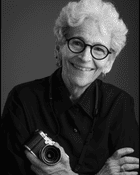I was a 21-year-old student at ArtCenter College of Design in California when I was assigned a documentary photography project. A model I was working with suggested I come and see a Hollywood hotel he was living in. It was fascinating. I could see there was quite a cast of characters there.
I’d always wondered who lived in this type of single-room occupancy hotel, where people might stay anything from one night to 30 years. I’d grown up in Wyoming, in a big house with a lawn and a dog, so it was foreign to me. I decided to move in and realised later, when I studied visual anthropology, that what I was doing was “participant observation”. I’ve continued to work like that throughout my career – become directly involved with my subjects for a long time. I’ve taken eight years to do a project.
Guest Register was relatively quick. I photographed and interviewed 36 people over three weeks. This fellow was the Sunday desk clerk. His dream was to have a roller rink in Pico Rivera, a neighbourhood in greater Los Angeles – not one that people necessarily aspire to. It wasn’t like saying: “I’m going to have a clothing store in Beverly Hills.” He was, in a certain way, the microcosm of the idea that dreams are for all of us.
He was very matter of fact – one might say, laconic. He was just doing his work, and he had to get along with people. The sign says: “No refunds. No pets without the manager’s approval.” There were pets of course, and he would have known. It was a live and let live kind of place.
I like the design of this photograph. It’s an example of a problem creating an opportunity. He was behind glass, so if I had photographed him straight on, I would have been reflected in the shot. I had to move over to the right side, which created a whole visual dynamic of angles and lines. I used a Hasselblad, with black and white film. At that time, you could make a Polaroid so that you knew that you were on the right path with your lighting and design. Once I was satisfied, I would make between 12 and 24 images.
The project was very well received and made the rounds of New York publishing houses. The art departments always wanted to publish it, but the bean counters would say: “Who’s gonna buy this book?” That went on for decades. I would show it to people and it brought me lots of Hollywood work and did wonderful things for me, but it didn’t get published. Then I kind of forgot about it until in 2018, when I showed the pictures at the Photography Master Retreat in France, and they all said: “This is brilliant. You must do something with it.” The pandemic gave me time to prepare it for publication.
Guest Register is a book of goals and dreams, some met and some not met. You can see the mail holder in the background of this image: each one of those slots represents a person, a life in the hotel. Many found a way to live that could bring them peace. Some would be over 100 if they were alive today. But there are others that were my age or younger, so I’m really excited to see if anyone comes forward once the book is published.
I consider this to be my magnum opus. We have our greatest intelligence in our early 20s. I think we spend the rest of our life trying to get back to that age of enlightenment. The hotel taught me many things that I have carried forward to this day. It gave me the confidence and the will to continue being this crazy thing called being a photographer.
Guest Register by Penny Wolin is published by Crazy Woman Creek Press. More information at pennywolin.com
Penny Wolin’s CV
Born: Cheyenne, Wyoming, 1953
Trained: ArtCenter College of Design in Pasadena, California. Master’s in the department of cultural anthropology at the University of California, film directing at the American Film Institute, Los Angeles.
Influences: “Diane Arbus, Arnold Newman, Margaret Bourke-White and Dorothea Lange. I have their books from my early career and they are dog-eared and worn.”
High point: “The 1992 solo exhibition at the Smithsonian Institution, Museum of American History, of The Jews of Wyoming: Fringe of the Diaspora, plus a Life magazine commission to photograph a monk who was building a monastery of contemplation and silence in the middle of a Nebraska cornfield.”
Low point: “The 21st-century shift in public perception that equipment can take the place of the concerned photographer. Wrong. Cameras don’t make great pictures. Photographers do!”
Top tip: “As the great portrait photographer Arnold Newman said: ‘Photography is 2% inspiration and 98% moving furniture.’ Move that furniture. Make photographs of what you understand or want to understand. Give yourself assignments with firm deadlines. Shoot, process, edit, print, repeat.”

